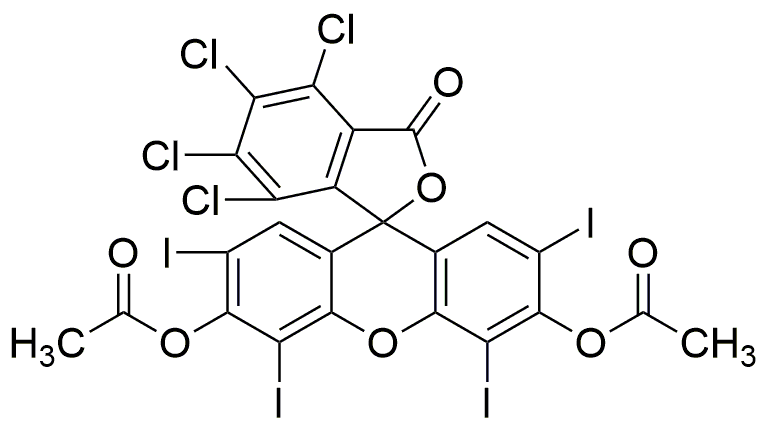Rose Bengal diacetate is widely utilized in research focused on:
- Photodynamic Therapy: This compound is effective in treating certain types of cancer by using light to activate the dye, which then produces reactive oxygen species that can kill cancer cells.
- Fluorescent Tracers: In biological research, it serves as a fluorescent marker, allowing scientists to visualize cellular processes under a microscope, enhancing the understanding of cell dynamics.
- Environmental Monitoring: It is used in assessing water quality, as it can indicate the presence of pollutants through its photochemical properties, aiding in environmental protection efforts.
- Histology and Pathology: The compound is applied in staining techniques, helping pathologists to identify and differentiate between various tissue types in diagnostic samples.
- Antimicrobial Applications: With its ability to generate reactive oxygen species, it shows promise in developing antimicrobial treatments, particularly against resistant bacterial strains.
Informations générales
Propriétés
Sécurité et réglementation
Applications
Rose Bengal diacetate is widely utilized in research focused on:
- Photodynamic Therapy: This compound is effective in treating certain types of cancer by using light to activate the dye, which then produces reactive oxygen species that can kill cancer cells.
- Fluorescent Tracers: In biological research, it serves as a fluorescent marker, allowing scientists to visualize cellular processes under a microscope, enhancing the understanding of cell dynamics.
- Environmental Monitoring: It is used in assessing water quality, as it can indicate the presence of pollutants through its photochemical properties, aiding in environmental protection efforts.
- Histology and Pathology: The compound is applied in staining techniques, helping pathologists to identify and differentiate between various tissue types in diagnostic samples.
- Antimicrobial Applications: With its ability to generate reactive oxygen species, it shows promise in developing antimicrobial treatments, particularly against resistant bacterial strains.
Documents
Fiches de données de sécurité (FDS)
La FDS fournit des informations de sécurité complètes sur la manipulation, le stockage et l’élimination du produit.
Spécifications du produit (PS)
Le PS fournit une description complète des propriétés du produit, notamment sa composition chimique, son état physique, sa pureté et les exigences de stockage. Il détaille également les plages de qualité acceptables et les applications prévues du produit.
Certificats d'analyse (COA)
Recherchez des certificats d'analyse (COA) en saisissant le numéro de lot du produit. Les numéros de lot et de lot se trouvent sur l'étiquette d'un produit, après les mots « Lot » ou « Lot de fabrication ».
Numéro de catalogue
Numéro de lot/série
Certificats d'origine (COO)
Ce certificat d'exploitation confirme le pays dans lequel le produit a été fabriqué, et détaille également les matériaux et composants utilisés et s'il est issu de sources naturelles, synthétiques ou autres sources spécifiques. Ce certificat peut être requis pour les douanes, le commerce et la conformité réglementaire.
Numéro de catalogue
Numéro de lot/série
Fiches de données de sécurité (FDS)
La FDS fournit des informations de sécurité complètes sur la manipulation, le stockage et l’élimination du produit.
DownloadSpécifications du produit (PS)
Le PS fournit une description complète des propriétés du produit, notamment sa composition chimique, son état physique, sa pureté et les exigences de stockage. Il détaille également les plages de qualité acceptables et les applications prévues du produit.
DownloadCertificats d'analyse (COA)
Recherchez des certificats d'analyse (COA) en saisissant le numéro de lot du produit. Les numéros de lot et de lot se trouvent sur l'étiquette d'un produit, après les mots « Lot » ou « Lot de fabrication ».
Numéro de catalogue
Numéro de lot/série
Certificats d'origine (COO)
Ce certificat d'exploitation confirme le pays dans lequel le produit a été fabriqué, et détaille également les matériaux et composants utilisés et s'il est issu de sources naturelles, synthétiques ou autres sources spécifiques. Ce certificat peut être requis pour les douanes, le commerce et la conformité réglementaire.


